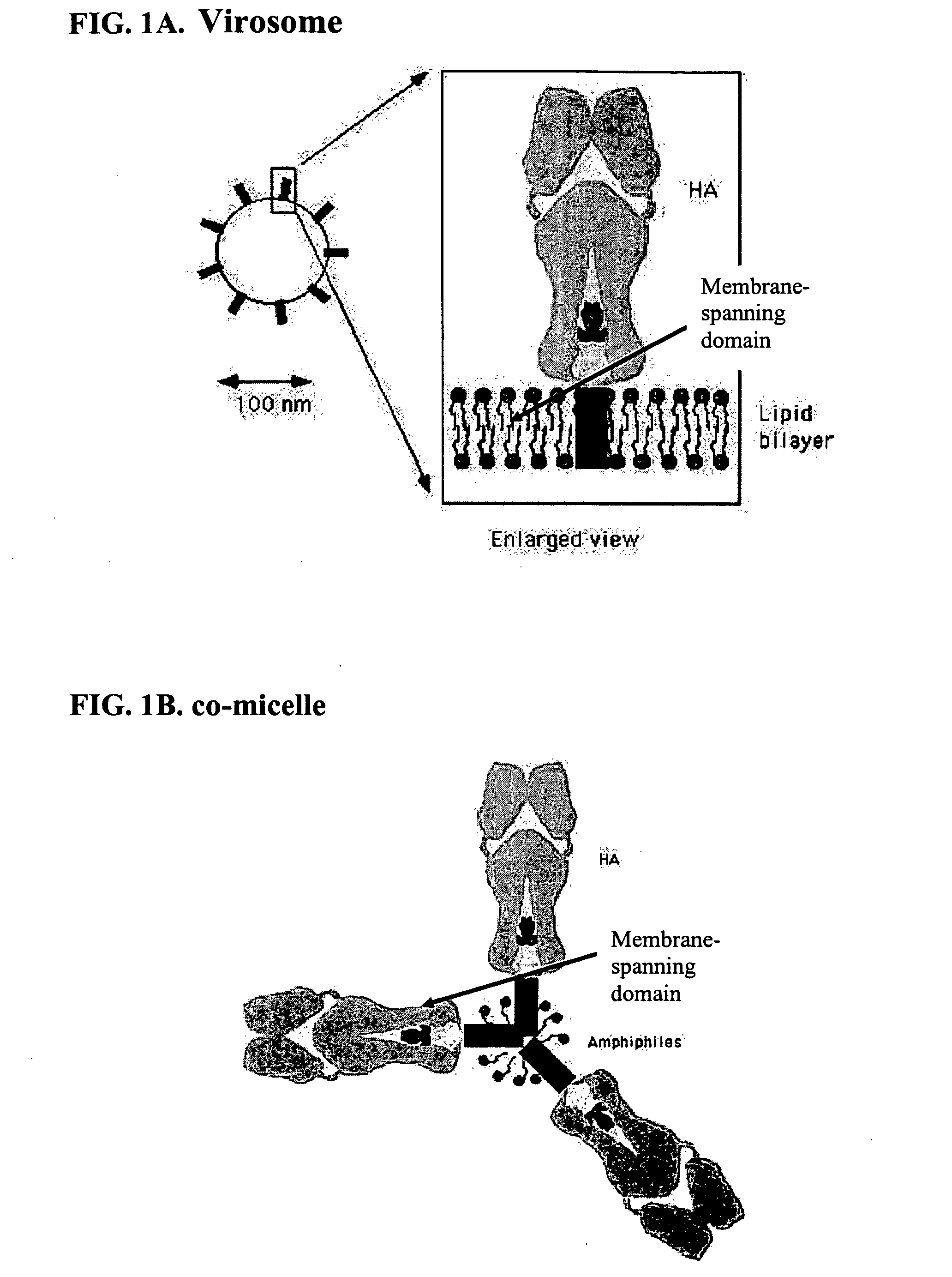Compositions comprising antigen-complexes, method of making same as well as methods of using the antigen-complexes for vaccination
a technology of complexes and complexes, applied in the field of biotechnology, can solve the problems of difficult antigen formulation of lipopeptides as part of commercial vaccines, inability to formulate lipopeptides as part of vaccines, and inability to achieve practical applicability, etc., to achieve the effect of improving water solubility and little practical applicability
- Summary
- Abstract
- Description
- Claims
- Application Information
AI Technical Summary
Benefits of technology
Problems solved by technology
Method used
Image
Examples
example 1
Production of a Lipopeptide-Influenza Membrane Protein Co-Micelle
[0044] Influenza virus was produced by growing virus acquired from the World Influenza Center in embryonated eggs, purified by differential ultra-centrifugation, and inactivated by formaldehyde treatment according to established standard procedures known by persons skilled in the art.
[0045] The purified and concentrated virus was incubated with a suitable detergent, such as beta-D-octylglucoside (Boehringer Mannheim, Del.) at a concentration of 60 mM (a concentration above the detergent's critical micelle concentration is required) for 30 minutes at 4° C., in an isotonic buffer at neutral pH: 145 mM NaCl, 2.5 mM HEPES, pH 7.4 (Buffer A). The viral nucleocapsid and matrix protein were then removed by centrifugation at 100,000 xg for 40 minutes at 4° C. The pellet was discarded and the supernatant was used for purification of viral glycoproteins by passing the supernatant over an affinity chromatography column containi...
example 2
Purification and De-Lipidation of the Influenza Membrane Glycoproteins on a DEAE Column
[0048] Formaldehyde-inactivated influenza virus was produced as in Example 1. The purified virus was concentrated by ultracentrifugation and the viral pellet was resuspended with beta-D-octylglucoside (Boehringer Mannheim, Del.) at a concentration of 60 mM for 30 minutes at 4° C. in a low-salt buffer: 10 mM TRIS, 1 mM EDTA, pH 7.4 (Buffer A). The viral nucleocapsid and matrix protein were then removed by centrifugation at 100,000 xg for 35 minutes at 4° C. The pellet was discarded, and the supernatant used for purification of viral glycoproteins.
[0049] The viral glycoproteins, mainly hemagglutinin (HA) and neuraminadase (NA), present in the supernatant containing the solubilized viral membrane, were then de-lipidated by application of the sample to a DEAE cellulose ion exchange column (Servacel, DEAE-GS, analytical grade cellulose ion exchanger: 1 ml packed column volume was used per 0.3 mg of v...
example 3
Production of N-palmitoyl-S-2,3(bispalmitoyloxy)-propyl-cysteinyl-seryl -(lysil)3-lysine influenza A / New Caledonia 20 / 99 membrane protein co-micelles and physicochemical characterization of co-micelle formation
[0053] The following steps are independent of the virus strain used. N-palmitoyl-S-2,3 (bispalmitoyloxy)-propyl-cysteinyl-seryl-(lysil)3-lysine, suspended in buffer A, containing 60 mM beta-D-octylglucoside, was added to the membrane proteins, purified as in example 2, typically at a ratio of 1 mg of proteins per mg of lipopeptide. Subsequently, the detergent was removed by extensive dialysis or ultrafiltration against a buffer isotonic with human physiological conditions at neutral pH: 145 mM NaCl, 2.5 mM HEPES, pH 7.4 (buffer F). Dialysis was carried out using a Slide-a-Lyzer (Pierce). The rate of detergent removal was carefully controlled to prevent aggregation, which could be followed by visual inspection, and typically required dialysis at a ratio of less than 1000 volum...
PUM
| Property | Measurement | Unit |
|---|---|---|
| diameter | aaaaa | aaaaa |
| diameter | aaaaa | aaaaa |
| volumes | aaaaa | aaaaa |
Abstract
Description
Claims
Application Information
 Login to View More
Login to View More - R&D
- Intellectual Property
- Life Sciences
- Materials
- Tech Scout
- Unparalleled Data Quality
- Higher Quality Content
- 60% Fewer Hallucinations
Browse by: Latest US Patents, China's latest patents, Technical Efficacy Thesaurus, Application Domain, Technology Topic, Popular Technical Reports.
© 2025 PatSnap. All rights reserved.Legal|Privacy policy|Modern Slavery Act Transparency Statement|Sitemap|About US| Contact US: help@patsnap.com



